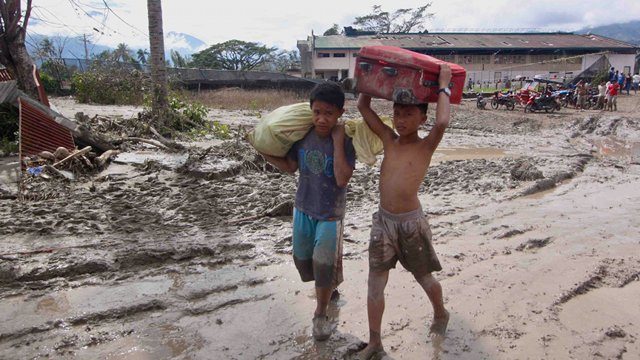SUMMARY
This is AI generated summarization, which may have errors. For context, always refer to the full article.

MANILA, Philippines – Unchecked illegal gold mining and decades of indiscriminate logging contributed to the high death toll in the Philippines’ worst natural disaster this year, officials and experts say.
Whole towns were washed away or buried by landslides when Typhoon Pablo (international codename: Bopha) smashed into a mountainous region on the southern island of Mindanao last week, leaving 548 people confirmed dead and 827 missing.
Poverty, greed and the lure of the precious metal have long drawn thousands of prospectors to the region.
“Mining and logging may have had an effect,” said civil defense chief Benito Ramos.
“The mountains have been denuded for decades, and filled with holes by our countrymen who are small-time miners. It pains me to say this, but these are the facts,” he said.
The worst-hit southern town of New Bataan is both a centre of the devastated banana industry and host to some of the thousands of illegal gold-mining operations in the Mindanao province of Compostela Valley.
Geologists say the mountainous area is mostly unsafe for habitation. But numerous small, illegal or poorly regulated gold mines dot its slopes and the local government says they provide 40 percent of the province’s economic output.
Much of the forest cover was also cut down long ago to make way for row upon row of bananas to supply the major markets of China, Iran and Japan.
The plantations and hopes of striking it rich have drawn hundreds of thousands of poor migrants in search of work. They settle in mountain hamlets around which poisonous mercury, used to extract gold from rock, is routinely dumped into rivers.
The deluge wrought by the strongest cyclone to hit the country this year came despite days of preparations and advance warnings including an early evacuation of vulnerable areas.
Governor Arthur Uy said 75,000 people, or one in five in the province, rely on the mines and regulation is a sore point.
The environment ministry insists it is the local officials like Uy who are required by law to issue small-scale mining permits and who must ensure people do not settle areas considered prone to landslides and flash floods.
But Uy protested that the ministry’s “geohazard maps” show that 80% of the entire province is a danger zone.
“What shall we do? Should we all move from Compostela Valley?” he said.
Uy also said miners had resisted efforts to relocate them, preferring the danger to poverty.
“It is the risk they are willing to take, just to strike it rich. They don’t want to move,” he said.
Larry Heradez, a technical officer for the Philippine government’s mining regulator, said people in New Bataan and nearby gold-rush areas may have known about the danger but sought refuge in the wrong areas.
“There is a problem of information dissemination. The local officials also thought they are evacuating to an area which was safe,” he told AFP.
Rescuers said government shelters were among buildings swept by the floods.
In any case, all the elements of a disaster in the making were already there long before geohazard maps came into fashion, said University of the Philippines geology professor Sandra Catana.
“They (have been) living in these areas before technology came about including the awareness of geohazards in this country which started only in 1990s,” she told AFP.
With Mindanao usually spared by the 20 or so storms that lash the Philippines every year, people may have become complacent and were caught unprepared by the typhoon which struck further south than usual, officials said.
But the head of a government flood control programme, Mahar Lagmay, warned that weather patterns were changing.
“Previously we have had tracks in the last several decades where (storms) were moving more to the north. Now, they say, it is moving towards the south,” he said.
Some 1,200 people were killed when tropical storm Washi struck Mindanao’s north coast in December last year, but Uy conceded that residents of his southern region never expected a killer storm like Bopha.
“This was the first time this happened to us, we did prepare… but we never felt anything this strong. We were taken by surprise. That is one of the reasons there were so many casualties,” he said. – Agence France Presse
Add a comment
How does this make you feel?
There are no comments yet. Add your comment to start the conversation.